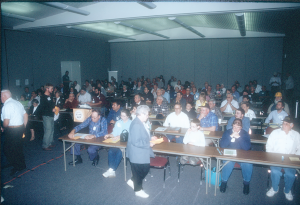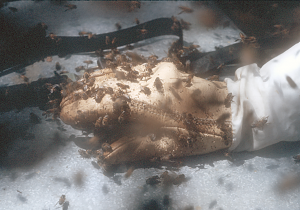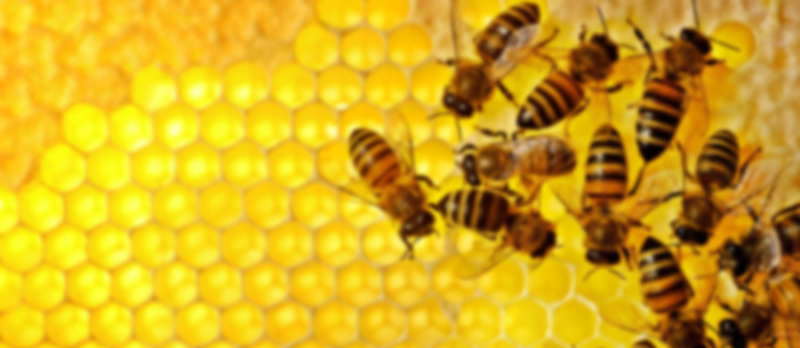By: James E. Tew
Beekeeping 2025 – Will hardly a decade really make that much of a difference?
What’s so special about 2025?
Well, being unable to foresee the future, I don’t know of anything that will be special about the year, 2025. I was recently asked to present a discussion at a state meeting, and this was the topic on which I was asked to speak. The group wanted something pertaining to the near future rather than a look at beekeeping far into the future. I suppose some guesses can be made about the randomly chosen year – 2025. I want to see if I can look backwards – which at one time was the future – to see if I can see trends that will predict events eight years from today.
Those who are older, please help me out.
I am shocked to do the simple arithmetic and realize that I will be 77 years old in 2025. Simply stated – wow! But looked at another way, 16 years ago, I was 52. I have written in previous articles that those of us who stay in beekeeping become inexonerably incorporated into beekeeping. While you and I age, beekeeping evolves and changes into something “newish.” We as human beekeepers just grow into older beekeepers. I got my first two hives of bees in 1973. That means I have – roughly – lived through three 16-year cycles. Maybe I can take selected beekeeping attributes from my first two+ 16 year cycles to shoot a trend-line out to 2025. (Really – will anyone remember this article in 2025? What do I have to lose?)
But first, some comments on predicting the unpredictable.
Sometime during 1946, two years before my birth, Dr. Percy Spencer1, a scientist with the Raytheon Corporation, was researching radar technologies – specifically a vacuum tube called a magnetron. He noticed that a chocolate candy bar had melted in his shirt pocket as he was standing near the vacuum tube device when it was being tested. Sensing something odd was on going, he placed some popcorn kernels near the tube. Within a few minutes, popped corn apparently splattered all over his lab. Later he put an egg near the device to show a co-worker the effects of the magnetron. The hot egg exploded on the face of the curious on-looker. Could a device with potential use in radar technology instead be used to cook food in the average home kitchen? We all know the answer to that. The very first microwave was six feet tall and weighed 750 pounds.
In 1928, Alexander Flemming2 noticed that a common mold Penicillium notatum destroyed colonies of Staphylococcus aureus. Though it had been observed innumerable times before, this casual observation was the beginning of the antibiotic era of medicine. Though others had noticed the mold’s effects, until then it was only considered to be a laboratory contaminant.
On a much more mundane – but important to me – subject, some of the best advances I have made in my use of Power Point and Photoshop have been due to key stroke errors. I call them the, “I didn’t know that would do that.” moment. Spencer was not trying to build a new type of oven. Flemming was not trying to develop an entirely new medical concept. And me – I was just trying to get my talks ready for some future meeting. My point is that a lot of science and technology is highly predictable while a lot is simply blind luck – even mistaken luck. We depend on that unanticipated luck as a way to advance science. Though helpful, such breakthroughs are unpredictable. In this article, there is no way for me to predict such future blind-luck beekeeping happenings. Maybe I should just make some up.
Bee meetings in 1977, 1993, and 2025
1977: Beekeeping was enjoying a cyclic growth boom. People wanted healthy food with healthy sugars. I ate bean sprout sandwiches and had long, dark, slightly wavy hair. In fact, long hair was in style and angry bees loved it. New beekeepers wanted their own hives. Package bees and good quality queens were plentiful. Traditional beekeeping was a hot item. Local honey sold well. Attendance at meetings was good and was growing. Presenters used slide projectors or overhead projectors. Talks had to be assembled weeks in advance. Since slides could not be edited, audiences accepted the frequent bad slide as a way of life. There were no laser pointers.

The Ohio State Beekeepers Association 1999 Fall meeting, Reynoldsburg, Ohio. Note the omnipresent Kodak slide projector in its’ place of prominence. This event was a major source of information transfer. There were no digital cameras, no camera phones and no WiFi connections. Yet, these people loved bees just as beekeepers do today.
1993: 16 years later, the Varroa mite was in the final stages of redesigning the bee industry of North America. Shock and dismay were common features of beekeeping as keepers thought they would never get either tracheal or Varroa mites. They had to accept the fact that their colonies would succumb to the mite invasion. Yet the public was fascinated by the concept of Killer Bees. The public treated pollination and concern for all bees’ welfare shabbily. But how could the public be blamed? Everywhere they were told that they would be stung to death by marauding killer bees. Beekeepers and landowners were concerned about legal issues.
In some instances, it was difficult to find beeyards. Attendance at meetings dropped. Beekeepers left the industry. Numbers of both bees and beekeepers declined. From an income standpoint, honey production was still more important than pollination. In 1993, computers were just beginning to change the way programs are presented. The world-wide-web was still very young.
2025: Beekeepers as old as Jim Tew are still at meetings and still remember the old bee days of the 60s and 70s. But unfortunately, much of that old information is nearly useless. Most presentations are electronic and are streamed from the web in real-time with immediate feedback between the audience and the speaker. In fact, many of the older people – like Jim – don’t actually attend the meeting but are there in electronic format. Actual attendance at the meeting is no longer required. Electronic devices that are a combination of today’s cell phone, digital phones, virtual computers, and wristwatch/computer contraptions will be used to gather bee information and participate in virtual bee meetings. (Honestly – much of this procedure could be happening now if a way of gathering registration fees could be generated. There will still be costs incurred in conducting virtual meetings, but presently most of us are accustomed to things on the Internet being free. )
Varroa mites are still around but are not much of an issue. Enough time has passed that an improved relationship has developed between bee strains that are more mite resistant and mites that are more bee tolerant. Time and research energy will be directed toward issues of virus infections and other pathogenic issues. Pending an unexpected breakthrough in genetic procedures, bees and queens will be pretty much as they are today but the way information is delivered will be significantly different.
Bees In 1977, 1993, and 2025
1977: I could buy 3# packages bees for $18-$25. The options of 2#, 3#, 4#, and 5# packages were common. (In the Spring of 2017, I will be paying about $120+ for a three-pound package.) In 1977, the US Mail Service was the primary source of delivery. The Railroad Express Agency (REA) had been an option for delivering bees and equipment, but was waning in importance. (Now packages are custom delivered by either the producer or by specialized beekeepers with equally specialized transportation equipment.)
Many “races” of queen stocks were available. Caucasian and Carniolan queens could still be purchased from several producers. Midnight and Starline queens were popular and were high quality queens. American foulbrood was the frightful disease of the day, but antibiotics and sulfa drugs were seen as modern techniques for combating such diseases. A.I. Root, Dadant, and Kelley were the major equipment producers and were helpful in getting new beekeepers off the ground and supporting established beekeepers. The A.G. Woodman Company in Grand Rapids, Michigan manufactured quality smokers for many years. During the 70s, Dadant Company bought the Woodman Company. All in all, the ‘70s was one of the pre-mite beekeeping Golden Ages. I am happy I was there for the experience.

Africanized honey bees attacking a beekeeper’s glove in Venezuela. While this type of bee continues to be a menace, it is no longer considered to be a problem for most beekeepers. The reputation of these bees undersandably frightened people.
1993: Package bees were still readily available and reasonably affordable. In 1990, Africanized honey bees had colonized southern Texas. By 1993, the infamous bee would turn to the Western U.S. much to the temporary relief of Eastern beekeepers. Some beekeepers and some states were still killing bees in order to save them. During the late 80s and early ‘90s, honey bees afflicted with tracheal mites or Varroa mites stood a good chance of being killed in order to control the spread of mites. As they are today, Africanized bees were normally killed as a way to protect society and the magaged honey bee population. To the honey bee population, this was much like “removing bad blood from an ailing patient.” In and around 1993, there was much confusion about the best type of bee to have. It should be hygienic, but the science was not yet perfect to breed hygienic bees. By 1995, all U.S. states documented Varroa mite finds. During the 1990s, beekeepers loved their bees as much as the beekeepers of today, but mites and Africanized honey bees made it a tough love.

Package bees being unloaded at the Cincinnati Post Office. This type of shipping has moved to specific drop points. Whether or not the U.S. Postal System will ever again be instrumental in distributing honey bee packages is unclear.
2025: Nine years from today, bees and their keepers will still be here. It’s more difficult to get package bees. Shipping and handling packages is expensive and is highly specialized. However, in 2025, many beekeepers are making Autumn splits and others are wintering bees in special insulated nucleus hive boxes. The nutritional needs of these overwintered bees will be better understood. Trace elements and vitamin needs are now met. Improved bee genetics allows for the selection of “designer” queens. In 2025, bees still sting, but genetic techniques will soon be available to breed a nearly stingless honey bee. While beekeepers of the 70s didn’t care for such sting-neutered bees, many modern beekeepers of 2025 will love them – as will their neighbors.
Bee management and pollination in 1977, 1993, and 2025
1977: Bee stocks were hardy and seemingly thrived even under the worst conditions. Many – if not most – new beekeepers took up bees because they found a swarm on their property. Pioneers of the day, like Brother Adam, were busy selecting for the perfect strain of honey bees. Bee breeders have been doing this selection process since the very beginnings of our bee industry. In 1977, chemicals were freely used but not as much as in the years immediately following World War II. Sodium sulfathiazole was still available from bee supply companies. In 1977, bee strains seemed strong and well adapted to their environment. American foulbrood was the biggest pathogenic fear. Commercial beekeepers and sideline beekeepers enjoyed significant numbers. It appeared that the industry was poised to grow. Though pollination was touted and honey bees were called, “angels of agriculture,” commercial bee pollination was still not a great income generator. Income from pollination usually subsidized honey prices. Otherwise, it was typical business. In fact, the beekeepers of today could readily work 1977 bee colonies. Don’t expect to see plastic frames in 1977 hives.
1993: While the Varroa/tracheal mite issue was still hot in 1993, for many U.S. beekeepers the shock was beginning to wear off. Six years earlier (1987), Canada had closed its border to the importation of bees from the U.S. This was a staggering blow to U.S. package and queen producers – one that would take years for recovery. Some operations didn’t recover.
Bee management was in an odd place in 1993. States without Africanized honey bees (AHB) wanted nothing to do with them. States that had them really didn’t know what to do with them. There was much talk about restricting incoming bees from AHB areas. This never formally happened, but beekeepers were frequently hostile toward other beekeepers who migrated from AHB areas. Making matters worse was Varroa and tracheal mite infestations. No one knew what to do with them either. Across the U.S., some bee colonies were strong and healthy while others harbored exotic pests or exotic genetics. Beekeeping was a patchwork of management schemes across the country. The Internet was playing an increasing role in information dispersal – with both correct and incorrect information. Oddly, it was an exciting time to be in beekeeping but not exactly a happy time for beekeeping. Pollination was frequently mentioned as a necessity to U.S. food production, but other battles had to be fought first.
2025: Improvements and advances in honey bee genetics and nutrition will have made bee stocks healthier and more productive. Pheromone and odor sensors will be important in telling the beekeeper what is happening inside the hive without having to open it. The chemical profile can be fed into a computer program that will show the characteristics of the hive. Aspects of this technology will also allow the queen to be more easily found and replaced. Indeed, most hives will have active connections to the Internet that will allow for remote monitoring. Happily, the Africanized Honey Bee issue is past.
Beehives will be made from composite (manufactured) wood/plastic products and will be better insulated against Winter cold and Summer heat. While bees – of all species – will still be important for pollination, increasingly, genetically modified plants will not require the high levels of pollinator populations of years past. New versions of artificial sweeteners will be developed and nutritionally enhanced foods will be readily available, but natural honey will still be coveted, as it becomes more of an antiquated oddity. The management schemes of commercial beekeepers will be significantly different from backyard beekeepers. The web will be the go-to source for most beekeeping instruction and information. Increasingly, bees and beehives will become virtual and remotely managed.
Obviously, I have been playing with this topic.
Obviously, I make no claim to being a visionary. Just as obviously, no one can tell anyone else what will be happening in 2025. But I am truly comfortable predicting this: Eight years from now, the bees will be pretty much as they are today, as they were in 1993, and as they were in 1977. Beekeepers and their gadgetry and understanding will be what will change. These have been some of the thoughts of Jim “Nostradamus” Tew.
 1Who Invented Microwave? http://www.todayifoundout.com/index.php/2011/08/the-microwave-oven-was-invented-by-accident-by-a-man-who-was-orphaned-and-never-finished-grammar-school/
1Who Invented Microwave? http://www.todayifoundout.com/index.php/2011/08/the-microwave-oven-was-invented-by-accident-by-a-man-who-was-orphaned-and-never-finished-grammar-school/
2Bellis, Mary. The History of Penicillin. http://inventors.about.com/od/pstartinventions/a/Penicillin.htm
 Dr. James E. Tew, State Specialist, Beekeeping, The Alabama Cooperative Extension System, Auburn University; Emeritus Faculty, The Ohio State University. Tewbee2@gmail.com; http://www.onetew.com; One Tew Bee RSS Feed (http://www.onetew.com/feed/); http://www.facebook.com/tewbee2; @onetewbee Youtube: https://www.youtube.com/user/onetewbee/videos
Dr. James E. Tew, State Specialist, Beekeeping, The Alabama Cooperative Extension System, Auburn University; Emeritus Faculty, The Ohio State University. Tewbee2@gmail.com; http://www.onetew.com; One Tew Bee RSS Feed (http://www.onetew.com/feed/); http://www.facebook.com/tewbee2; @onetewbee Youtube: https://www.youtube.com/user/onetewbee/videos











